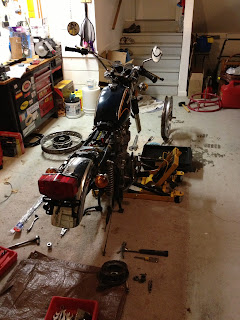Saturday/Sunday, 01.26/27.2013: Spent a good portion of this last weekend oiling my air filters, de-rusting parts, and putting things back on the frame. I had really high hopes of the bike starting. I tested the spark plugs by laying each plug on top of the engine and stepping on the kick pedal. Both of them shot sparks, so that would imply that my spark plug wires and ignition coils are still good. I soldered a severed wire for the back right turn signal. I checked and adjusted the gaps for my contact breaker points... The list goes on and on. I was going to take off the stator (alternator) cover and check and adjust ignition timing, but decided against it until I drained the oil again. There seems to be some oil inside of that cover. Surely the alternator isn't completely submerged in oil, but I'm wondering if it has some sort of self oiling mechanism that lets some of the oil in from the left crankcase?
I also lubed up the throttle cable with some PB Blaster. The housing was broken in a couple of spots and was causing the throttle grip to stick open. Amazingly the PB Blaster fixed it. Aesthetically, it may not be the prettiest cable to look at, but it has definitely sprung back to life!
Anyway, got her back to together Sunday morning, poured some fuel in the tank. Turned the (new) fuel petcock from off to on and... nothing. So, we turned it all the way over to reserve and finally started to see some gas flow down through my new 1/4" clear fuel lines and inline fuel filters all the way to the carburetors. So far, so good! I turned the key in the ignition switch, closed the choke, and pressed the starter button... Amazingly the starter sounded pretty healthy considering the bike has been sitting for so long. It wanted to start so badly (or maybe it was me who wanted the bike to start so badly?)! My buddy, George, noticed that the left carb overflow vent was working (i.e. the float height needed adjusted because the gas was filling up inside of the carbs float bowl and overflowing). And so that meant taking the left carb back off of the bike, draining it, and then opening the float bowl. I built a homemade float height gauge out of an old O'Charley's gift card (the float height needed to be 20mm). Strange thing is, the height was closer to 22mm when I took my initial measurement and you'd think, if anything, that it would have been less than 20mm and would have been the cause of the float not doing its job of keeping gas from filling up and overflowing like it was. For grins, I went ahead and adjusted it to 20mm anyway. Buttoned it back up and put it back on the bike.
I poured a little more gas in the tank this time - thinking that perhaps that was why the petcock's 'on' setting wasn't working previously - turned the petcock to 'on' and nothing... Turned it all the way over to 'reserve' and nothing. Gas flow to the carbs work by gravity. So, it could be that there was some residue that I wasn't able to rinse out of the tank that ended up clogging my new petcock. Or, maybe the inline fuel filters I bought had already clogged? To troubleshoot this, I'll likely just disconnect the fuel lines at the carbs and work my way up the lines, to the filters, then to the petcock, and finally the tank. Good times!
Well, it's back to the drawing board...
Here are a few pics of how things were shaping up prior to yesterday's attempts at starting her up.












































